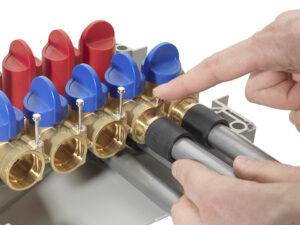 Now more than ever, building services professionals are under pressure to deliver projects to tight deadlines, while keeping costs down. As space becomes even more of a premium in most installations, they face further challenges to deliver high-performance systems into compact areas. With this in mind, Steve Richmond, Head of Marketing and Technical at REHAU Building Solutions, explores how manifold plumbing could ease the strain of these installations.
Now more than ever, building services professionals are under pressure to deliver projects to tight deadlines, while keeping costs down. As space becomes even more of a premium in most installations, they face further challenges to deliver high-performance systems into compact areas. With this in mind, Steve Richmond, Head of Marketing and Technical at REHAU Building Solutions, explores how manifold plumbing could ease the strain of these installations.
Building services engineers working on residential projects are challenged with delivering high-quality installations to ever-tighter deadlines. On top of this, the responsibility of keeping material cost down quickly means there is little room for complicated piping networks with many joints. However, when space in building projects is limited to small utility cupboards and pipes running through floors or ceilings, it can be difficult to reduce the amount of material required to create a complex pipework route.
As with many trades on-site, each aspect of an installation must be completed quickly so the overall construction time can be kept to a minimum. Therefore, it is vital that whichever method is chosen can be fitted quickly and without disruption. As sites can bring with them a whole raft of challenges, it could be worth considering installing alternative plumbing systems that meets these challenges.

The manifold option
Manifold plumbing systems use pipework from a central distribution manifold, often in a utility cupboard, that go to each outlet. Unlike traditional branch plumbing, they feature continuous free pipes to the radiators, taps or appliances, so there is no extra jointing required. Thanks to this reduction in jointing, there are fewer individual components needed, reducing installation time and cost for the materials required.
Further to this, manifold plumbing makes the maintenance and upkeep of a property much quicker and less invasive. With a branch plumbing system, all jointing and isolation points are concealed under floors or in ceilings. This means it is impossible to isolate sections of the system without turning off the water supply completely, and disruptive work like tearing up the floorboards is impossible. When water is distributed through an easily accessible manifold in a utility cupboard, each part of the system can be isolated with the valves on the unit. If only one radiator or one sink needs maintenance, that part can be isolated without disruption to the rest of the house or water supply.
Suitable applications
Manifold plumbing solutions are ideal for settings where space is at a premium for a number of reasons. For example, in a new-build apartment development, building services are often limited to a very small utility cupboard or void in the wall. Using a space-saving manifold system, the plumbing for the entire property can be reduced to pipework and the centralised distribution point.
Though this is true of any new build where space is at a premium, also helps for any development subjected to tight deadlines. The reduced jointing and simplified connections of most manifold solutions means the time spent by plumbing contractors in the property will be minimised. If there are multiple trades battling for space, as well as against the deadline, this reduced installation time could prove very helpful to all parties involved.
Choosing the correct solution
When opting for a manifold solution, building services engineers consider not only the manifold itself, but also the pipework being installed with it. To face the challenges around reducing installation time while ensuring high performance, they should consider a fully integrated system. To help building services engineers and their contractors broach these issues, suppliers such as REHAU have worked on manifold plumbing solutions which save on space and installation time without compromising performance for end users.
Manifold systems such as Smart Link plumbing manifold from REHAU are compact enough to fit into small utility cupboards, giving full access for isolation later on. From this central point, there are five cold and four hot water outlets that can supply radiators, taps and other outlets through compatible pipework. For building services professionals who require complete flexibility in a variety of spaces, this sort of modular system can provide a solution no matter how small the space.
With safety and hygiene remaining vital priorities, it is important that water supplies are uncontaminated. With this in mind, polymer multilayer composite pipe (MCLP) has been developed for safety and system-wide performance. RAUTITAN, the MCLP from REHAU, is compatible with the Smart Link manifold, and through its smooth surface eliminating deposit build-up helps deliver a hygienic water supply to occupants.
While the creation of affordable housing, particularly high-rise buildings, further increases, the pressure on building services engineers to deliver low-cost plumbing solutions in record time will only grow. Using modular solutions that reduce the number of individual components, they will be able to provide homes that suit the requirements of occupants long into the future.
For more information about REHAU’s Smart Link plumbing manifold and their MLCP RAUTITAN, visit: http://www.rehau.uk/rautitan

